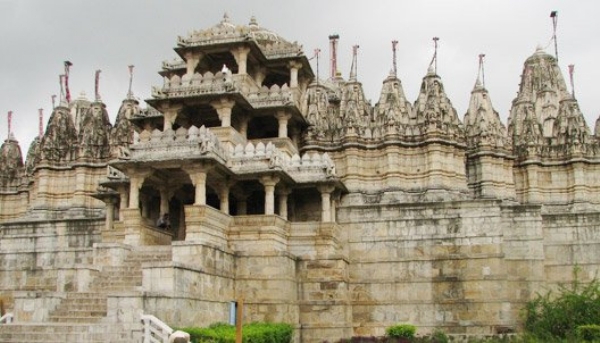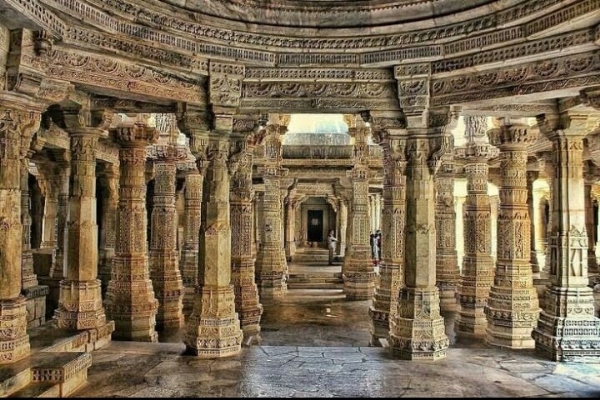Ranakpur Jain temple: A masterpiece of architecture in Rajasthan
The Chaumukha Temple here is the most prominent amongst all the temples present in the complex
Total Views |
If you want to witness a true masterpiece of architecture, then this temple, an underrated gem, is the one for you. Spread across 4,500 square yards, consisting of 29 halls, the Ranakpur Jain Temple is one of the most important of the 5 major pilgrimage sites of Jainism. Also called the Chaturmukha Dharana Vihara, the temple dedicated to Tirthankara Rishabhanatha is located in Pali district of Rajasthan. This temple is known all over the world for its brilliant architecture & was even voted amongst the top 77 wonders of the world!

History | The Mewar Dynasty had always patronised the building activities of the Jain community. Dhanna Shah, a Porwal from Ghanerao, got a dream about a celestial vehicle and wanted to construct this temple. He approached Rana Kumbha, requesting him to provide him with a part of the land, so that he could start construction. Rana Kumbha agreed, but on one condition - that the constructed temple should bear his own name. Hence, the temple site on the banks of River Maghai came to be known as Ranakpur.
Architecture | The vast temple complex of the Ranakpur Temple comprises of - the Chaumukha Temple, the Parsavanath Temple, the Amba Mata Temple and the Surya Temple. The Chaumukha Temple is the most prominent amongst all these. Chaumukha temple is dedicated to the first Tirthankara, Adinath. The temple is constructed in the shape of a heavenly aircraft, and has 29 halls and 80 domes, with 1,444 pillars of intricately carved figures of goddesses. The striking temple has four entrances on four sides, which lead to the central chamber and sanctum having a statue of Lord Adinath.

With a basement of 48,000 square feet, the temple complex of the Ranakpur Temple includes a total of four shrines with pillared halls and domes that are supported by 1,444 intricately carved columns. No two columns in the temple have a similar design. The ceilings are finely carved with fine scrollwork & geometric patterns. The brackets connecting the top of the domes to the floor are filled with figures of deities, while the dome is in concentric bands.

This temple is located on Girnar hill, near Sadri Town in Pali District of Ranakpur. It is located around 90 kms from Udaipur. It takes approx. 4 hours via road to reach here from Udaipur. It is dedicated to Adinath, who was the first Tirthankar of present half-cycle / 'avasarpi' according to Jain cosmology. Constructed during the reign of Rana Kumbha, the Rajput monarch in the 15th century, the complex has 4 shrines.
Dhanna Shah, who was a local Jain businessman, saw a divine vision and undertook the construction of the temple. The architectural style and stone carvings of this temple are based on the ancient Mirpur Jain Temple that is located at Mirpur, Rajasthan.
The Three Jewels of #Rajasthan
— Pravesh Jain © (@SolarisePravesh) May 27, 2020
1. Ranakpur Jain Temple
The Jain temple rises to three stories supported by 1,444 carved marble pillars. Notably, no pillar has similar designs and are in fact truly unique.
1/n@bahubali09 @vinayak_jain #jainism
@_bhaarratpati @sourabh806 pic.twitter.com/MqJ1AmhiSQ
The temple is a 'chaumukha' one, which means it has 4 faces. This marvellous structure carved in stone is well known all across India for its distinctive architecture style. The unique feature of the temple is its colour-changing columns. They turn from golden to pale blue after every hour that passes during the day. Each column has been carved intricately without repeated designs. No two columns in the temple have similar designs! There are also two huge bells in the prayer hall, which give a pleasant sound when struck.
Also Read | Patwon ki Haveli: the 19th century grandeur of Jaisalmer!
Deepaka lead the architecture of this grand temple, and the construction of it went on until 1458 CE. The magnificent temple has had timely renovation since then. In the past century, the glorious temple has been managed by the Anandji Kalyanji Pedhi Trust.
Architecture | The vast temple complex of the Ranakpur Temple comprises of - the Chaumukha Temple, the Parsavanath Temple, the Amba Mata Temple and the Surya Temple. The Chaumukha Temple is the most prominent amongst all these. Chaumukha temple is dedicated to the first Tirthankara, Adinath. The temple is constructed in the shape of a heavenly aircraft, and has 29 halls and 80 domes, with 1,444 pillars of intricately carved figures of goddesses. The striking temple has four entrances on four sides, which lead to the central chamber and sanctum having a statue of Lord Adinath.

The style of construction of the temple and the quadrupled image symbolizes the Tirthankara's conquest of the four cardinal directions and hence stand as a symbol of cosmos. The architecture is based on ancient the Mirpur Jain Temple at Mirpur, Rajasthan.
With a basement of 48,000 square feet, the temple complex of the Ranakpur Temple includes a total of four shrines with pillared halls and domes that are supported by 1,444 intricately carved columns. No two columns in the temple have a similar design. The ceilings are finely carved with fine scrollwork & geometric patterns. The brackets connecting the top of the domes to the floor are filled with figures of deities, while the dome is in concentric bands.
Also Read | Shiva temple, Ambernath: The 1000-year-old gem in Mumbai!
The temple's foundation is made of 3 levels, so that the several pavilions can be accommodated on the base. Lovely turrets rise from the walls, where each of them relates to a cell on the inner facade of the wall. The roof is formed of 5 spires and 20 cupolas. The prayer hall has two huge bells weighing 108 kgs each. The Temple of Parsavanath is another temple that is worth visiting. Built in the middle of the 15th century, it is famous for its engraved windows that are embellished with Jain figures and is also known as Patriyon Ka Mandir.


